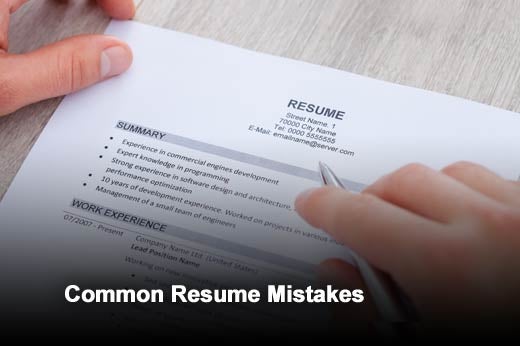Writing your resume is simple, right? You just open up a Word document and start dumping your responsibilities, a few metrics, and just the right amount of keywords onto the page. And voila, that pesky task is done. Wrong! Resumes are strategic marketing communications that must be created thoughtfully and with oomph.
Books are written on the subject and still careerists struggle. One blog post or article cannot comprehensively guide you on building that perfect resume. That said, in bits, bytes and chunks, we can construct tips and strategies and highlight everyday mistakes to avoid to help you get out of the resume-writing starting gate. This slideshow features five common resume mistakes, identified by Jacqui Barrett-Poindexter, MRW writing for Glassdoor.com, along with solutions to fix them so you can more readily land that next great job.
Click through for five common resume mistakes and ways you can fix them, as identified by Glassdoor.com.
Mistake #1: Using an objective. For example: “To leverage my past experience and education to secure a finance management position.” Objective statements traditionally are about you, but today’s resume should be focused on their (employer’s) needs.
How to fix: Replace the objective with a focused headline and profile summary that markets your value to alleviate a company’s pain. Example headline:
Financial Analyst
Transforming complex business problems in technology sector into focused, data-backed solutions.
Driving down costs, elevating reporting capabilities and improving decision-making processes.
Mistake #2: Not including your most persuasive information above the fold. While the resume doesn’t stop after the first paragraphs or bullets or even after the first half of the page, ‘above-the-fold’ marketing does matter.
How to fix: If you want to hook the reader, don’t bore them right out of the gate. Grab their attention with sizzle. So, instead of the profile summary just saying that you are a skilled financial manager with 15 years of experience, power up the message with an achievement. Example:
Most recently, contributed as financial manager for a large automotive group in Kansas City, MO, a position acquired by rising through the ranks of ABC Automotive Company from the sales floor. In this leadership role, consistently performed in top 5% of the company’s pool of 20 finance managers.
Mistake #3: Writing in the third person. For example: Kevin Jones offers extensive experience as a project management professional.
How to fix: Convert to implied first person. Example:
Offer more than 10 years of project management experience with expertise in applying novel efficiency and productivity solutions.
Mistake #4: Including a picture. While the value of LinkedIn rises when you post a photo to your social media profile, the same is not true for your resume. When it comes to pasting a picture into your resume file, don’t. Doing so may create problems for human resources screeners in regard to equal opportunity issues.
How to fix: Simply do not include a photo. Paint vivid word pictures and stories, instead. And if you like, add a few splashes of color, a chart or graph or other impressions that add value while adding flair.
Mistake #5: Using overused words. For example: visionary, dynamic leader, results-oriented, passion, integrity.
How to fix: Because some of these words regularly are woven into formal job postings, it is difficult to avoid using them altogether if you want to meet the applicant tracking system (ATS) needs some companies have. So, if you do use these buzzwords, be sparing. As well, when you DO use them, be sure to build a contextual story around those words either at the time of use or later in the resume. In other words, prove, through concrete achievements, that you are visionary, or that you have integrity. Example:
Leadership Impact: Captained a mission and vision focus on profitability. Engineered a >$15 million turnaround in one year, shifting unit from quarterly loss of ($8 million) to $7 million profit in Q4 2011.








